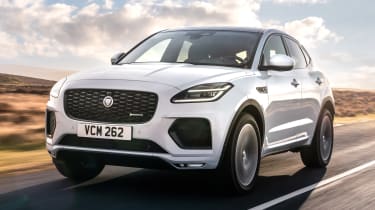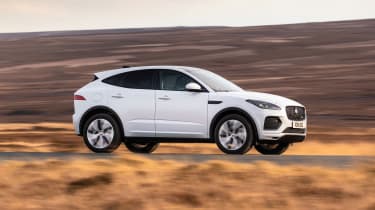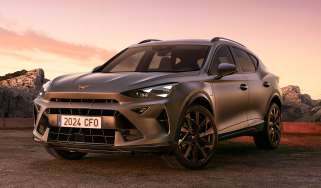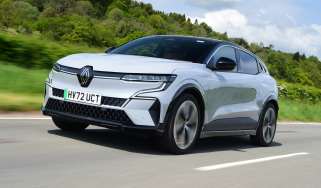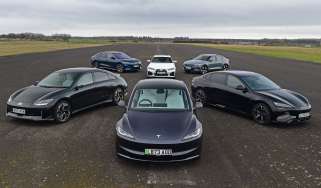Jaguar E-Pace review - Engines, performance and drive
E-Pace boasts good steering and is decently grippy, but engines are dull and it feels a little heavy

Jaguar’s engineers were hit with a demanding task for the pre-facelift E-Pace; how do you apply the Range Rover Evoque’s heavy D8 platform to an SUV which buyers will expect a degree of driver engagement from?
The answer was evidently ‘with some difficulty’, but the need to produce a PHEV model has also helped to solve the problem as the new platform comes with a significant weight saving. At least it does before the PHEV batteries are added, which should mean the petrol and diesel variants feel a little more nimble. A similar approach in the latest Discovery Sport certainly paid dividends.
That said, the pre-facelift E-Pace hits back against its kerbweight with decent driving dynamics. Push on and you’ll feel the car’s weight for sure, more so than in a BMW X1 or X2, as the E-Pace picks up a bit more body roll and a weighty nose prone to washing out into understeer. It’s safe rather than fun, but at eight tenths it feels composed and could even be described as agile. Jaguar has equipped the E-Pace with a decent power steering system too, which is well weighted, responsive and delivers good feedback considering it’s an electric system. It is a little weighty around town though.
More reviews
Car group tests
In-depth reviews
Road tests
- New Jaguar E-Pace P300e PHEV 2021 review
- New Jaguar E-Pace D150 manual 2018 review
- New Jaguar E-Pace D240 diesel review
- Jaguar E-Pace HSE review
Used car tests
All-wheel-drive models are kitted with Jaguar’s Active Driveline system enabling torque vectoring on the rear axle, although the difference it makes isn’t game changing. You’ll feel a little tug at the rear as the inside rear wheel is braked, and the outside is fed more power, with up to 100 per cent of the rear axle’s torque available in just one corner of the car. It’ll sharpen your line but won’t put a huge smile on your face, and the extra grip quickly gives way to understeer.
All but the entry level, front-wheel-drive D165 car are available or equipped with adaptive dampers. With these, you’ll be able to configure the E-Pace into a relatively comfortable SUV, though the Volvo XC40 remains softer and better at soaking up bumps.
In the new P300e PHEV, which is the heaviest of the latest line-up at nearly 2.2 tonnes, we found the ride to be a little fussy on pock-marked urban roads. Acceleration feels decent with the three-cylinder petrol engine and electric drive transitions coming smoothly, and the engine itself never sounding thrashy in spite of its relatively small size.
The PHEV’s significant weight only really makes itself felt during more aggressive cornering, too, but the E-Pace is best enjoyed as a comfortable and luxurious fast cruiser when it comes into its own.
0-62mph acceleration and top speed
The D165 diesel model is no longer available, but if you track down a used model you'll have a two-litre four-cylinder unit serving up 161bhp and 380Nm of torque. It doesn’t feel sluggish, and for many this might be all the performance you’ll need – a 10-second 0-62mph dash and a top speed of 128mph is respectable enough. The AWD MHEV auto version manages 0-62mph in 9.8 seconds.
The real pick of the current engine line-up is probably the more powerful D200 MHEV diesel. It’s the same four-cylinder unit, only with the wick turned up to 201bhp and 430Nm of torque - taking 8.4 seconds from 0-62mph and topping out at 131mph. It’s respectably refined and smooth but the auto gearbox could be a little better. It’s Jaguar’s implementation of a ZF transmission, and it can get caught out from time to time.
The entry petrol P160 manages the same 0-62mph sprint in 10.5 seconds, while the 246bhp P250 model needs 7.5 seconds, The highly-strung four-cylinder unit is pacey but not outrageously so, and it’s not particularly exciting either, producing a flat, uninspiring engine note. It’ll prove very costly to run, too.
A more efficient option is the new P300e PHEV. Thanks to its 305bhp the plug-in model will crack 0-62mph in 6.5 seconds.
Which Is Best
Cheapest
- Name2.0 D165 5dr 2WD
- Gearbox typeManual
- Price£31,265
Most Economical
- Name1.5 P300e R-Dynamic S 5dr Auto
- Gearbox typeAuto
- Price£48,870
Fastest
- Name1.5 P300e R-Dynamic S 5dr Auto
- Gearbox typeAuto
- Price£48,870

